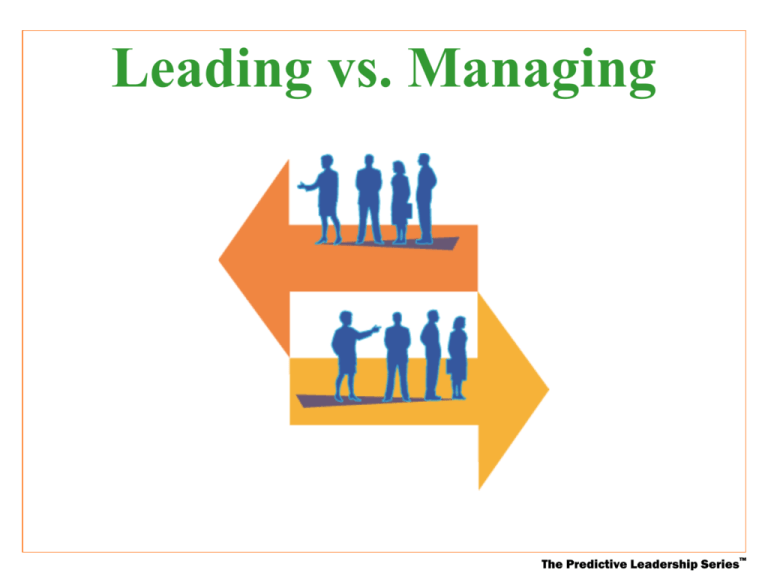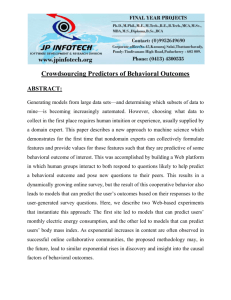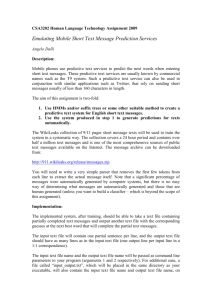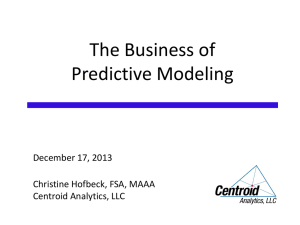
Leading vs. Managing
Leading vs. Managing
The Predictive Leadership Series™
®
PI
People Smart. Results Driven.®
Paula Hein
Predictive Index
®
PI Midwest
The Predictive Leadership Series™ is a flexible, solutions-based suite of workshops designed
to help improve effectiveness and productivity throughout your organization.
Predictive
Selection and
Interviewing
Predictive
Selling
Personal
Development
Strategies
Setting the
Right Goals
Building
Teams
People Smart
Communication
Resolving
Conflict
Leading Vs.
Managing
PI
Empowering
Your
Organization
Leading vs. Managing
Leading vs. Managing
Part of the Predictive Leadership Series
• Benefits to you
Predictive
Selling
Predictive Selection
and
Interviewing
Setting the
Right Goals
Personal
Development Strategies5
People Smart
Communications
Building Teams
Resolving
Conflict
Leading
Vs. Managing
> Understand the
importance of behavior
in leading and managing
> Recognize whether a
situation requires
leading or managing
Empowering Your
Organization
• Outcome
PI
> Learn strategies to move
between leading and
managing
The Predictive Leadership Series™
Leading vs. Managing
Overview
Learning Objectives
• Understand your Behavioral Assets
• Understand the importance of behavior associated with
leading and managing
• Recognize whether a situation requires leading or
managing
• Learn strategies to move between leading and
managing
Page 2
The Predictive Leadership Series™
Leading vs. Managing
Overview
Process
• Facilitator-led review and discussion of :
> Predictive Index
> Definitions of Leading and Managing
> The Differences Between Leading and Managing
• Participant exercises utilizing the following PI Tools:
> PI Pattern - Behavioral Asset Inventory worksheet
> Leading vs. Managing Worksheet
> Case Studies
> Action Plan
Page 2
The Predictive Leadership Series™
Leading vs. Managing
Agenda
•
•
•
•
•
•
•
•
•
Welcome
Let’s do this now:
Introductions
Name, position, department, time
in the job you have now
Predictive Index Overview
Behavioral Asset Inventory
Individual Potential
Leading vs. Managing
Case Study
Action Plan
Summary and Close
Page 3
The Predictive Leadership Series™
Leading vs. Managing
Predictive Index
Praendex is the publisher of the Predictive Index, a unique
executive management tool that recognizes the work-related
behaviors and motivational needs of employees. In addition,
Praendex designs and administers workplace training and
development programs to improve organizational effectiveness and
productivity. Praendex is the parent company of PI Management
Resources, a worldwide association of experienced management
consultants.
• Established 1955
• 3,500 Clients Worldwide
• Provides an objective, factual, and analytic assessment of personal qualities and
motivational factors that are strong predictors of future behaviors
Page 4
The Predictive Leadership Series™
Leading vs. Managing
Factors
• People are motivated by fundamental needs or
drives which lead to certain behaviors.
• In PI, we call these motivating needs “Factors.”
The foundation of our ability to leverage our strengths and
bridge our weaknesses is Self-awareness
Page 5
The Predictive Leadership Series™
Leading vs. Managing
Factors
Factor A - measures the drive to exert one’s influence on people and events.
Factor B - measures the drive for social interaction with other people.
Factor C - measures the intensity of a person’s tension and pace.
Factor D - measures the drive to conform to formal rules and structure.
NORM
AVERAGE
LOW Relative to Norm
Unassuming, Unselfish
A
Extroverted, Sociable
EXTROVERSION
B
Driving, Intense
Patient, Relaxed
PATIENCE
C
Informal, Independent
Page 5
Dominant, Assertive
DOMINANCE
Reserved, Introspective
D
Relative to Norm HIGH
Formal, Conforming
FORMALITY
The Predictive Leadership Series™
Leading vs. Managing
Factor E
• Factor E - measures the degree to which emotion
affects decision making and judgment.
> Low E indicates a tendency toward subjective
or intuitive thinking.
> High E indicates a tendency toward objective
or logical thinking.
Subjective
Page 6
L
H
Objective
Norm
Average
The Predictive Leadership Series™
Leading vs. Managing
Factor M
• Factor M - measures your reaction to your
environment.
> More Focused- indicates a need for personal motivation in
order to adapt; these individuals are not easily distracted by
their environment.
> More Stimulated- indicates an ability to readily adapt to
change.
More Focused
More Stimulated
> 50
< 50
M
Norm
Average
Page 6
The Predictive Leadership Series™
Leading vs. Managing
Predictability
Generally
Predictable
Very
Predictable
Very
Predictable
Extremely
Predictable
5+
4
Extremely
Predictable
3
2
1
1
2
3
4
5+
A Dominance
12
8
B
2
Patience
14
“Lower”
C
Formality D
Extroversion
“Higher”
36
0 = Balanced Norm
Each Factor represents a drive to behave in a certain way, and each is different
from the others. Some Factors are more strongly expressed than others, which
is what accounts for the differences between us.
The Predictive Leadership Series™
Leading vs. Managing
Behavioral Asset Inventory
• A tool that translates your PI pattern into descriptions of
behavioral characteristics.
• Your Behavioral Assets do not change, you just get better
at utilizing those assets as you gain experience.
Your Behavioral Asset Inventory has been completed
Let’s review it now………..
Page 8
The Predictive Leadership Series™
Behavior is one aspect of a person’s Assets. Also
consider knowledge, education, experience, and skills.
A number below indicates the degree of predictability.
The text provides an indication of behavior you can
expect.
0 = Situational
Behavioral Asset Inventory for:____________________
Allan Bremerton
5
2 = Very predictable
3+ = Extremely predictable
1
0
1
2
3
4
5
(C) Patience
(D) Formality
77
1
2
(A) Dominance
(E)
Dominance
3
(B) Extroversion
1 = Generally predictable
Sigma
4
Subjective/Intuitive
Objective/Logical
Response Measure: Gauges Adaptability, Energy adds emphasis to the observed behavior
Lower
Higher
Agreeable, accommodating, cooperative
Venturesome, competitive, resourceful
Private, task oriented, reserved, independent
Open, communicative, outgoing, upbeat
Patience
2
2
Intense, multi-tasking, variety, quick, urgency
Stable, consistent, methodical, steady
Formality
1
Flexible, just do it, uninhibited, delegator
Specific, careful, planner, diligent, rules
Extroversion
A over B
Analytical, technical, self-dependant, my way, problem solver, authoritative, critical, resourceful
B over A
1
People oriented, service to others, includes & empowers others, positive, team oriented, shares
A over C
3
Proactive, starter, new ways, initiative, take charge, enjoys pressure, move forward, ambitious
C over A
Reactive, stable, steady, consistent, maintains the pace, deliberate, dependable, tolerant
A over D
Risk taker, decisive, action, production, get it done, strategic, generalist, starter
D over A
B over C
2
3
C over B
B over D
Risk averse, do it right, specialist, conservative, result-based decisions, careful to do it right
Quick to connect to people, reads people, includes others, optimistic, enthusiastic, persuasive
Takes time to connect to & trust people, reserved, serious, skeptical, independent, introspective
2
Informal, poised, delegation to others, good mixer, flexible, casual when not interested
D over B
Formal, serious, disciplined thinking, factual, reserved, skeptical, independent, tactical
C over D
Casual with the rules, find my own way, delegates freely, loose structure, do it now - worry later
D over C
1
Careful with the rules, follow up, planner, options organizer, consequences vs. my actions
Leading vs. Managing
Behavioral Asset Inventory
• The Behavioral Asset Inventory is a tool that
translates your PI pattern to descriptions of
behavioral characteristics.
> What does your Behavioral Asset Inventory tell you
about how you would lead or manage?
> Cite an example of when you have used your
behavioral assets in a leading or managing situation.
Page 8
Complete exercise as explained on page 8 in your workbook.
The Predictive Leadership Series™
Leading vs. Managing
Individual Potential
The importance of behavior
Experience
Skills
Knowledge
Attitudes & Values
Interests
Literacy &
Language
Education &
Training
Physical & Health
Intelligence
Take into consideration all of the
information that makes up the whole
person. This illustration shows how
important behavior is in assessing
individual potential.
Behaviors,
Motivating Needs,
Drives, Aptitudes,
& Styles
Page 9
The Predictive Leadership Series™
Leading vs. Managing
Leading vs. Managing
• Hersey, Blanchard and Johnson:
> Leading occurs when one person attempts to influence the
behavior of another individual or group - regardless of the reason.
> Managing involves a process of working with and through
others, and other resources (e.g., equipment, capital and
technology) to accomplish organizational goals.
• We believe that
> Leading involves setting the vision for the organization and
communicating that vision to the team, inspiring them to dedicate
their efforts to realize the vision.
> Managing ensures the day-to-day execution of the plan, making
sure team members are focused, productive, and rewarded for the
incremental steps necessary to realize the vision.
Page 10
The Predictive Leadership Series™
Leading vs. Managing
Leading vs. Managing
Leading
Managing
Strategic Thinking
Tactical Thinking
• Understand the vision
• Communicate the
vision
• Inspire others to
realize the vision
• Ensure day to day
execution and plan
• Keep team members
focused, productive
• Recognize and reward
We are all expected to be good leaders and good managers
when we hold a position of management within an
organization.
Page 11
The Predictive Leadership Series™
Leading vs. Managing
Leading
Strategic Thinking: Long-range View
• Vision
> What is our vision of the future?
• Mission
> What is our business purpose?
• Values
> What values to we want to demonstrate?
• Strategic Goals
> What will take us into the future we envision?
• Leadership
> What are we doing to develop our future leaders?
Page 12
Complete exercise as explained on page 12 in your workbook.
The Predictive Leadership Series™
Leading vs. Managing
Leading
Behavioral Assets
• Using the Insights reference grid on page 13, circle the
behaviors that correspond to your Behavioral Asset
Inventory.
> Which of your natural behavioral strengths can you
leverage when you are leading?
> Are there any challenges you may face when leading?
Page 13
The Predictive Leadership Series™
Leading vs. Managing
Managing
Tactical Thinking: Short-range view
• Processes
>
>
>
>
What must get done?
With what measurable results?
What are our key work processes?
What are our customer and supplier requirements?
• Functions
> Marketing, Sales, Operations, Service
• Do our functions support our processes, organizational vision, and strategy?
• Jobs
> Key Results
•
•
•
•
Page 14
Do we know the demands of each job?
Do we have the right people in the right jobs?
What are the behavioral requirements of each job?
Are the jobs aligned with our vision, strategy, functional and process goals?
Complete exercise as explained on page 14 in your workbook.
The Predictive Leadership Series™
Leading vs. Managing
Managing
Behavioral Assets
• Referring to the Insights reference grid on page 15,
circle the behaviors that correspond to your
Behavioral Asset Inventory.
> Which of your natural behavioral strengths can you
leverage when you are leading?
> Are there any challenges you may face when leading?
Page 15
The Predictive Leadership Series™
Leading vs. Managing
Case Studies
You are a manager of the department in all examples below:
1) Your team is experiencing a lag in productivity in the past 3 months. What behaviors and
actions would you demonstrate to manage the situation? What behaviors and
actions would you demonstrate to lead the situation?
2) The company is changing health care providers to reduce associated costs. Employees have a
choice between two types of programs. You are not happy about the change but you
understand the financial impact on the company if the change is not made. The deadline
for your department to submit the change request is two weeks. What behaviors and
actions would you demonstrate to manage the situation? What behaviors and
actions would you demonstrate to lead the situation?
3) Sales has over-committed a re-design request to a new client to be delivered in 2 weeks. Your
design team was not prepared for this work load and you will need to juggle projects
around to accommodate the design request. What behaviors and actions would you
demonstrate to manage the situation? What behaviors and actions would you
demonstrate to lead the situation?
Page 16
The Predictive Leadership Series™
Leading vs. Managing
Action Plan
• During the course of this workshop, you have:
> Reviewed the Predictive Index
> Reviewed your Behavioral Asset Inventory
> Examined the differences between Leading and Managing
> Identified your natural behaviors as they relate to your
approach to leading and managing
> Practiced analyzing situations and determining the
appropriate actions
Page 17
The Predictive Leadership Series™
Leading vs. Managing
Action Plan
Review the challenge you recorded on your Action Plan at the
beginning of the workshop. Make any revisions if necessary.
Action Steps
>
Action steps should be specific, achievable in a realistic time frame, and measurable
Leverage Behaviors
>
Which of your natural behavioral strengths will you leverage?
Modify Behaviors
>
Which of your natural behaviors might you have to modify to meet the challenge?
Resources, Measurements, and Time frames
>
What resources will I need? (people, technology, finances etc.)
>
How will I measure my success?
>
When will I measure my success?
Page 17
The Predictive Leadership Series™
Allan Bremerton
8/7
Date: ______________
Action Plan
Name: _____________________________________
I currently manage 7 service reps. We have experienced turnover in the past 3 months
Identify the situation/challenge
and my team is having a difficult time keeping up with current work load. Also, productivity is down due to morale issues
and conflict between two employees.
Action Steps
What actions will you take?
Hire the right
people for the
job
Behaviors
Which behaviors will you
Which will you modify?
leverage?
A/D –
delegate
Establish
productivity goals
with team and
post status daily
for team to see
progress and
results
A/C – Get
results, get the
job done
Address conflict
issues between
individuals and
coach
B/C – Good
w/people –
communicate,
encourage,
inspire
Copyright, 2001, Praendex Incorporated. All rights reserved.
D/C – follow up
on issues and get
more involved in
the day-to-day
work
Low C – take time
to listen to
employees,
provide ongoing
positive feedback,
and recognize
daily progress
Resources
What resources will I
need?
Measurements
Did I get what I wanted?
PI
Retention
Productivity
chart to post
on wall and
update daily
Productivity #’s
are moving up
monthly
My teams
active support
-Training new
hires
-Encouraging
team members
Team works
together to
resolve
conflict issues
constructively
The Predictive Leadership Series™
Leading vs. Managing
Summary & Close
As a leader and manager, understanding yourself and others is vital.
Never assume that what motivates you is the same as what
motivates others. Whenever possible, utilize your natural strengths
and the natural strengths of others to maximize success and
satisfaction. Your self-awareness and understanding of others will
help you to identify when you may need to draw on the strengths of
others to achieve success in certain situations.
Page 18
The Predictive Leadership Series™
®
PI
People Smart. Results Driven.®
Thank You








